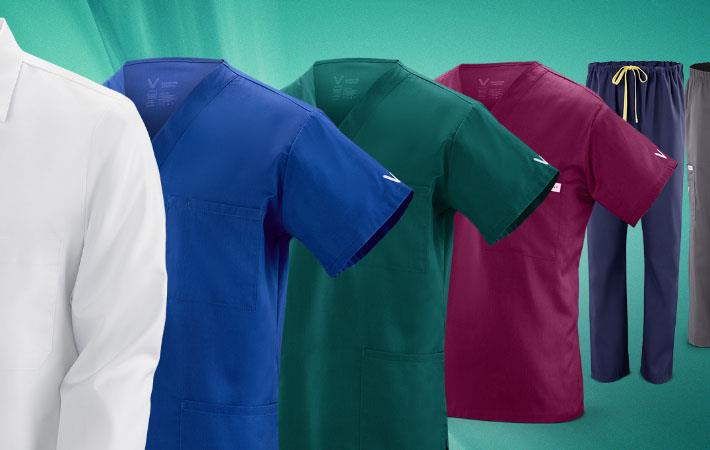The studies have shown that Vestex effectively repels fluids and reduces the bioburden of certain tested multi-drug resistant microorganisms on the fabric by more than 99 per cent compared to conventional medical scrubs. Vestagen Protective Technologies develops Vestex Active Barrier fabric healthcare uniforms, lab coats and patient garments.
The studies show that Vestex effectively repels fluids and reduces the bioburden of certain tested multi-drug resistant microorganisms on the fabric by more than 99 per cent compared to conventional medical scrubs.The studies have shown that Vestex effectively repels fluids and reduces the bioburden of certain tested multi-drug resistant microorganisms on the fabric by more than 99 per cent compared to conventional medical scrubs. Vestagen Protective Technologies develops Vestex Active Barrier fabric healthcare uniforms, lab coats and patient garments.#
Healthcare workers routinely experience unanticipated exposures to potentially hazardous fluids, including body fluids such as blood or urine, or hazardous drugs such as chemotherapeutics. Most workers currently have little warning of, and limited protection from, these exposures - the International Safety Center’s Exposure Prevention Information Network (EPINet) reports that 52 per cent of these unanticipated exposures occur during care at the patient bedside and 30 per cent involve unprotected skin.
One study addresses unanticipated exposures by assessing the fluid repellency effectiveness of conventional healthcare uniforms and Vestex active barrier uniforms. Three well-accepted standard testing methods were conducted on each set of garments by an independent ISO-accredited fabric testing facility using simulated body fluids and hazardous drugs.
The study results show that the fluid repellent effectiveness of the Vestex garments was superior to the conventional healthcare uniforms for all test and simulated fluids. The conventional uniforms failed to repel the fluids in all three tests and were deemed non-protective, while the Vestex garments successfully repelled all the tested fluids. While Vestex is not intended to replace PPE (Personal Protective Equipment) when fluid exposures are anticipated; based on these findings, the authors recommend that healthcare professionals should evaluate replacing traditional scrubs with active barrier garments such as Vestex as an additional way to minimise their everyday risks from unanticipated fluid exposures.
Healthcare workers are also routinely at risk of exposure to microorganisms capable of transmitting disease. Current worker uniforms have been shown to rapidly acquire and retain microorganisms during the work shift. These microorganisms may pose risks to workers, patients and their communities. The second study was designed to assess the effectiveness and durability of Vestex active barrier garments compared to conventional healthcare worker uniforms in reducing the bioburden of certain tested multi-drug resistant microorganisms on the garment.
Scientists at an IAC-certified antimicrobial testing laboratory used the Splatter Fabric Challenge (SFC) assay to test the antimicrobial efficacy of Vestex and conventional healthcare worker uniforms against common healthcare-related microorganisms, including the gram-positive bacteria Enterococcus faecium (VRE) and the gram-negative bacteria carbapenem-resistant Klebsiella pneumoniae (KPC) and Acinetobacter baumannii. The SFC test has been shown to accurately simulate worst case, real-world microbial transmission mechanisms encountered with textiles during normal use in healthcare environments. Antimicrobial effectiveness was tested at 0, 15, 30 and 60-minute time intervals in new garments and after 30 and 50 wash/dry cycles.
This study shows that Vestex garments were much more effective than conventional uniforms at reducing the bioburden of the three multi-drug resistant organisms on the fabric. Vestex demonstrated rapid bioburden reductions of greater than 99 per cent on the garments at all four intervals compared to conventional uniforms. The effect was also durable--there was minimal loss of antimicrobial efficacy after multiple wash/dry cycles.
These data are consistent with previous laboratory and clinical studies conducted on the bioburden reduction efficacy of Vestex fabrics for multi-drug resistant organisms. They strongly correlate with the findings of the controlled, blinded MRSA (methicillin-resistant Staphylococcus aureus) clinical trial conducted by Bearman et al and an in vitro study by Hardwick et al using Vestex fabric. The authors of the new study conclude that Vestex is more effective than conventional uniforms at reducing the bioburden of the tested microorganisms on the fabric and could reduce the overall bioburden of healthcare worker garments.
“These new studies conducted by respected independent laboratories provide additional scientific evidence that our Vestex Active Barrier garments can help protect workers and patients from unanticipated exposures to the potentially dangerous fluids and microorganisms that are common in healthcare settings,” said Ben Favret, founder and president of Vestagen. “The findings align well with previous studies of the protective qualities of Vestex and reinforce why Vestex was recently awarded the coveted Innovative Technology designation from Vizient, the largest member-driven healthcare performance improvement company in the US.”
Vestex Active Barrier fabric is a unique combination of technologies used to produce comfortable, continuous-wear healthcare worker and patient garments intended to minimise the risks associated with unanticipated exposure to body fluids during routine use, by repelling fluid splatter and spills from the fabric. A peer reviewed hospital-based study published in a leading medical journal showed reduced acquisition and retention of certain microorganisms on Vestex scrubs compared to conventional healthcare uniforms. Vestex contains an EPA-registered antimicrobial agent and has been shown in controlled conditions in laboratory and hospital settings to inhibit the growth of certain bacteria on the fabric. (SV)
Fibre2Fashion News Desk – India


